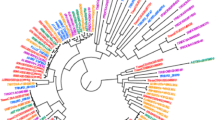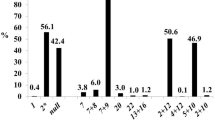Abstract
Genetically diverse wheat samples, twenty-seven Triticum aestivum L. varieties, grown in two environments (Portugal and Spain) were analyzed for their allelic composition in high-molecular-weight glutenin subunits (HMW-GS), low-molecular-weight glutenin subunits (LMW-GS) and puroindolines, as well as their protein content, hardness, sodium dodecyl sulfate-sedimentation (SDS-S), mixograph mixing time and breakdown resistance (MT and BDR, respectively) parameters, and R5 reactivity. The environment showed significant effect on protein content, SDS-S and BDR parameters. In relation to HMW-GS quality effect, the allelic composition Glu-A1d, Glu-B1al, Glu-D1d presented the best results. From the complex Glu-3 loci (LMW-GS), only Glu-B3 locus showed a significant effect on the quality parameters. The Glu-B3ab allele is desirable considering the higher mean values for SDS-S, MT and hardness, and the lower mean values for BDR. Regarding puroindolines, Pina-D1a, Pinb-D1c allelic composition (Leu to Pro at position +60) showed the best quality potential. In addition, we found negative (SDS-S and MT) and positive (BDR) significant correlations between quality parameters and the amount of potential celiac disease toxic epitopes, suggesting that wheat breeding aiming at quality does not have a negative impact on wheat toxicity and on the other hand, emphasizes the need for a more comprehensive wheat breeding programs that encompass celiac disease problematic.

Similar content being viewed by others
References
Kasarda DD (2013) Can an increase in celiac disease be attributed to an increase in the gluten content of wheat as a consequence of wheat breeding? J Agric Food Chem 61(6):1155–1159. doi:10.1021/jf305122s
Ribeiro M, Nunes-Miranda JD, Branlard G, Carrillo JM, Rodriguez-Quijano M, Igrejas G (2013) One hundred years of grain omics: identifying the glutens that feed the world. J Proteome Res 12(11):4702–4716. doi:10.1021/pr400663t
Shewry PR, Halford NG, Tatham AS, Popineau Y, Lafiandra D, Belton PS (2003) The high molecular weight subunits of wheat glutenin and their role in determining wheat processing properties. Adv Food Nutr Res 45:219–302
Payne PI, Corfield KG, Blackman JA (1979) Identification of a high-molecular-weight subunit of glutenin whose presence correlates with bread-making quality in wheats of related pedigree. Theor Appl Genet 55(3):153–159. doi:10.1007/bf00295442
D’Ovidio R, Masci S (2004) The low-molecular-weight glutenin subunits of wheat gluten. J Cereal Sci. doi:10.1016/j.jcs.2003.12.002
Bietz JA, Shepherd KW, Wall JS (1975) Single-kernel analysis of glutenin: use in wheat genetics and breeding. Cereal Chem 52(4):513–532
Payne PI, Lawrence GJ (1983) Catalogue of alleles for the complex gene loci Glu-A1, Glu-B1 and Glu-D1 which code for high-molecular-weight subunits of glutenin in hexaploid wheat. Cereal Res Commun 11:29–35
Rogers WJ, Payne PI, Seekings JA, Sayers EJ (1991) Effect on breadmaking quality of x-type and y-type high molecular weight subunits of glutenin. J Cereal Sci 14(3):209–221. doi:10.1016/S0733-5210(09)80040-4
Jackson EA, Holt LM, Payne PI (1983) Characterisation of high molecular weight gliadin and low-molecular-weight glutenin subunits of wheat endosperm by two-dimensional electrophoresis and the chromosomal localisation of their controlling genes. Theor Appl Genet. doi:10.1007/bf00281844
Gupta RB, Shepherd KW (1990) Two-step one-dimensional SDS-PAGE analysis of LMW subunits of glutelin. 1. Variation and genetic control of the subunits in hexaploid wheats. Theor Appl Genet. doi:10.1007/bf00224017
Ikeda TM, Araki E, Fujita Y, Yano H (2006) Characterization of low-molecular-weight glutenin subunit genes and their protein products in common wheats. Theor Appl Genet. doi:10.1007/s00122-005-0131-z
Harberd NP, Bartels D, Thompson RD (1985) Analysis of the gliadin multigene loci in bread wheat using nullisomic-tetrasomic lines. Mol Gen Genet MGG 198(2):234–242. doi:10.1007/bf00383001
Gupta RB, Paul JG, Cornish GB, Palmer GA, Bekes F, Rathjen AJ (1994) Allelic variation at glutenin subunit and gliadin loci, Glu-1, Glu-3 and Gli-1, of common wheats. I. Its additive and interaction effects on dough properties. J Cereal Sci 19(1):9–17
Morris CF (2002) Puroindolines: the molecular genetic basis of wheat grain hardness. Plant Mol Biol 48(5–6):633–647. doi:10.1023/a:1014837431178
Bhave M, Morris CF (2008) Molecular genetics of puroindolines and related genes: regulation of expression, membrane binding properties and applications. Plant Mol Biol 66(3):221–231. doi:10.1007/s11103-007-9264-6
Igrejas G, Leroy P, Charmet G, Gaborit T, Marion D, Branlard G (2002) Mapping QTLs for grain hardness and puroindoline content in wheat (Triticum aestivum L.). Theor Appl Genet 106(1):19–27. doi:10.1007/s00122-002-0971-8
Park CS, Kang CS, Cheong YK, Jung W, Woo SH (2010) Influence of puroindoline genotypes on grain characteristics, physico-chemical properties of flour and end-use quality of Korean wheats. Breed Sci 60(3):233–242
Brites CM, Santos CALd, Bagulho AS, Beirão-da-Costa ML (2008) Effect of wheat puroindoline alleles on functional properties of starch. Eur Food Res Technol 226(5):1205–1212. doi:10.1007/s00217-007-0711-z
Payne PI, Law CN, Mudd EE (1980) Control by homologous group 1 chromosomes of the high molecular weight subunits of glutenin, a major protein of wheat endosperm. Theor Appl Genet 58:113–120
Singh NK, Shepherd KW, Cornish GB (1991) A simplified SDS-PAGE procedure for separating LMW subunits of glutenin. J Cereal Sci. doi:10.1016/s0733-5210(09)80039-8
McIntosh RA, Devos KM, Dubcovsky J, Rogers WJ, Morris CF, Appels R, Somers DJ, Anderson OA (2008) Catalogue of gene symbols for wheat. http://wheat.pw.usda.gov
McIntosh RA, Dubcovsky J, Rogers WJ, Morris C, Appels R, Xia XC (2011) Catalogue of gene symbols for wheat. http://wheat.pw.usda.gov
Liu L, Ikeda TM, Branlard G, Peña RJ, Rogers WJ, Lerner SE, Kolman MA, Xia X, Wang L, Ma W, Appels R, Yoshida H, Wang A, Yan Y, He Z (2010) Comparison of low molecular weight glutenin subunits identified by SDS-PAGE, 2-DE, MALDI-TOF-MS and PCR in common wheat. BMC Plant Biol 10(1):1–24. doi:10.1186/1471-2229-10-124
Espí A, Giraldo P, Rodriguez-Quijano M, Carrillo JM (2012) A PCR-based method for discriminating between high molecular weight glutenin subunits Bx7 and Bx7* in Triticum aestivum L. Plant Breed 131(5):571–573. doi:10.1111/j.1439-0523.2012.01961.x
Ragupathy R, Naeem HA, Reimer E, Lukow OM, Sapirstein HD, Cloutier S (2008) Evolutionary origin of the segmental duplication encompassing the wheat GLU-B1 locus encoding the overexpressed Bx7 (Bx7OE) high molecular weight glutenin subunit. Theor Appl Genet 116(2):283–296. doi:10.1007/s00122-007-0666-2
Saghai-Maroof MA, Soliman KM, Jorgensen RA, Allard RW (1984) Ribosomal DNA spacer-length polymorphisms in barley: mendelian inheritance, chromosomal location, and population dynamics. Proc Natl Acad Sci 81(24):8014–8018
AACC (1995) Approved methods of the AACC, 9th edn. Methods 39-11; 39-70A; 76-31; 50-11; 54-30A; 54-40A
Dick JW, Quick JS (1983) A modified screening test for rapid estimation of gluten strength in early generation durum wheat breeding lines. Cereal Chem 60:315–318
Finney KF, Shogren MD (1972) A ten-gram mixograph for determining and predicting functional properties of wheat flours. Bak Dig 46:32–47
Osman AA, Uhlig HH, Valdes I, Amin M, Mendez E, Mothes T (2001) A monoclonal antibody that recognizes a potential toxic repetitive pentapeptide epitope in gliadins. Eur J Gastroenterol Hepatol 13(10):1189–1193
Kahlenberg F, Sanchez D, Lachmann I, Tuckova L, Tlaskalova H, Mendez E, Mothes T (2006) Monoclonal antibody R5 for detection of putatively coeliac-toxic gliadin peptides. Eur Food Res Technol 222(1–2):78–82. doi:10.1007/s00217-005-0100-4
Babay E, Hanana M, Mzid R, Slim-Amara H, Carrillo JM, Rodríguez-Quijano M (2015) Influence of allelic prolamin variation and localities on durum wheat quality. J Cereal Sci 63:27–34. doi:10.1016/j.jcs.2015.01.008
Ribeiro M, Carvalho C, Carnide V, Guedes-Pinto H, Igrejas G (2011) Towards allelic diversity in the storage proteins of old and currently growing tetraploid and hexaploid wheats in Portugal. Genet Resour Crop Evol 58(7):1051–1073. doi:10.1007/s10722-010-9642-9
Mohammadi M, Mehrazar E, Izadi-Darbandi A, Najafian G (2013) Genotype diversity of puroindoline genes (Pina-D1 and Pinb-D1) in bread wheat cultivars developed in Iran and CIMMYT. J Crop Improv 27(4):361–375. doi:10.1080/15427528.2013.775988
Zhang Y, He ZH, Ye GY, Aimin Z, Van Ginkel M (2004) Effect of environment and genotype on bread-making quality of spring-sown spring wheat cultivars in China. Euphytica 139(1):75–83
Surma M, Adamski T, Banaszak Z, Kaczmarek Z, Kuczynska A, Majcher M, Lugowska B, Obuchowski W, Salmanowicz B, Krystkowiak K (2012) Effect of genotype, environment and their interaction on quality parameters of wheat breeding lines of diverse grain hardness. Plant Prod Sci 15(3):192–203. doi:10.1626/pps.15.192
Dhaliwal AS, Mares DJ, Marshall DR (1987) Effect of 1B/1R chromosome-translocation on milling and quality characteristics of bread wheats. Cereal Chem 64(2):72–76
Ohm JB, Chung OK (1999) Gluten, pasting, and mixograph parameters of hard winter wheat flours in relation to breadmaking. Cereal Chem 76(5):606–613. doi:10.1094/Cchem.1999.76.5.606
Guo G, Jackson DS, Graybosch RA, Parkhurst AM (2003) Asian salted noodle quality: impact of amylose content adjustments using waxy wheat flour. Cereal Chem 80(4):437–445. doi:10.1094/Cchem.2003.80.4.437
Nelson JC, Andreescu C, Breseghello F, Finney PL, Gualberto DG, Bergman CJ, Pena RJ, Perretant MR, Leroy P, Qualset CO, Sorrells ME (2006) Quantitative trait locus analysis of wheat quality traits. Euphytica 149(1–2):145–159. doi:10.1007/s10681-005-9062-7
Moonen JHE, Scheepstra A, Graveland A (1982) Use of the SDS-sedimentation test and SDS-polyacrylamidegel electrophoresis for screening breeder’s samples of wheat for bread-making quality. Euphytica 31(3):677–690. doi:10.1007/bf00039206
Preston KR, March PR, Tipples KH (1982) An assessment of the SDS-sedimentation test for the prediction of Canadian bread wheat quality. Can J Plant Sci 62(3):545–553. doi:10.4141/cjps82-083
Bekes F, Gras PW, Gupta RB, Hickman DR, Tatham AS (1994) Effects of a high Mr glutenin subunit (1Bx20) on the dough mixing properties of wheat flour. J Cereal Sci 19(1):3–7. doi:10.1006/jcrs.1994.1002
Payne PI, Nightingale MA, Krattiger AF, Holt LM (1987) The relationship between HMW glutenin subunit composition and the bread-making quality of British-grown wheat varieties. J Sci Food Agric 40(1):51–65. doi:10.1002/jsfa.2740400108
He ZH, Liu L, Xia XC, Liu JJ, Peña RJ (2005) Composition of HMW and LMW glutenin subunits and their effects on dough properties, pan bread, and noodle quality of Chinese bread wheats. Cereal Chem. doi:10.1094/cc-82-0345
Liu L, He ZH, Yan J, Zhang Y, Xia XC, Peña RJ (2005) Allelic variation at the Glu-1 and Glu-3 loci, presence of the 1B/1R translocation, and their effects on mixographic properties in Chinese bread wheats. Euphytica. doi:10.1007/s10681-005-1682-4
Gupta RB, Singh NK, Shepherd KW (1989) The cumulative effect of allelic variation in LMW and HMW glutenin subunits on dough properties in the progeny of two bread wheats. Theor Appl Genet 77(1):57–64. doi:10.1007/bf00292316
Lillemo M, Morris FC (2000) A leucine to proline mutation in puroindoline b is frequently present in hard wheats from Northern Europe. Theor Appl Genet 100(7):1100–1107. doi:10.1007/s001220051392
Lebwohl B, Ludvigsson JF, Green PH (2015) Celiac disease and non-celiac gluten sensitivity. BMJ 351:h4347. doi:10.1136/bmj.h4347
Camarca A, Anderson RP, Mamone G, Fierro O, Facchiano A, Costantini S, Zanzi D, Sidney J, Auricchio S, Sette A, Troncone R, Gianfrani C (2009) Intestinal T cell responses to gluten peptides are largely heterogeneous: implications for a peptide-based therapy in celiac disease. J Immunol 182(7):4158–4166. doi:10.4049/jimmunol.0803181
Ribeiro M, Rodriguez-Quijano M, Nunes FM, Carrillo JM, Branlard G, Igrejas G (2016) New insights into wheat toxicity: breeding did not seem to contribute to a prevalence of potential celiac disease’s immunostimulatory epitopes. Food Chem 213:8–18. doi:10.1016/j.foodchem.2016.06.043
Acknowledgments
This work was supported by Grant Acción Integrada Hispano-Portuguesa, HP 2007-0085 and No. AGL 2012-38345 from the Ministerio de Economía y Competitividad in Spain and Acção Luso-Espanhola N.º E-121/08 from Conselho de Reitores das Universidades Portuguesas. Miguel Ribeiro and Luís Pinto have PhD fellowships (SFRH/BD/82334/2011 and SFRH/BD/81307/2011, respectively) granted by the Foundation for Science and Technology (FCT) and European Social Fund (ESF).
Author information
Authors and Affiliations
Corresponding author
Ethics declarations
Conflict of interest
The authors declare no conflict of interest.
Compliance with ethics requirements
This article does not contain any studies with human or animal subjects.
Rights and permissions
About this article
Cite this article
Ribeiro, M., Rodríguez-Quijano, M., Giraldo, P. et al. Effect of allelic variation at glutenin and puroindoline loci on bread-making quality: favorable combinations occur in less toxic varieties of wheat for celiac patients. Eur Food Res Technol 243, 743–752 (2017). https://doi.org/10.1007/s00217-016-2788-8
Received:
Revised:
Accepted:
Published:
Issue Date:
DOI: https://doi.org/10.1007/s00217-016-2788-8




